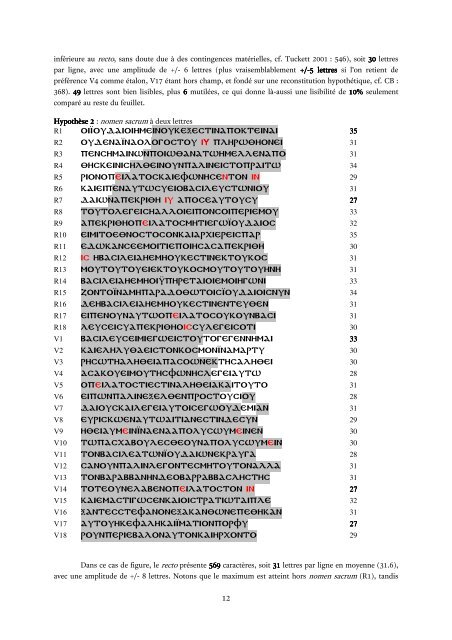Le P52 (P. Rylands.Gr.457) contenait-il un nomen sacrum pour "Jésus" ?
Examen de la présence ou non des nomina sacra dans le plus ancien manuscrit grec du Nouveau Testament.
Examen de la présence ou non des nomina sacra dans le plus ancien manuscrit grec du Nouveau Testament.
You also want an ePaper? Increase the reach of your titles
YUMPU automatically turns print PDFs into web optimized ePapers that Google loves.
inférieure au recto, sans doute due à des contingences matérielles, cf. Tuckett 2001 : 546), soit 30 lettres<br />
par ligne, avec <strong>un</strong>e amplitude de +/- 6 lettres (plus vraisemblablement +/ +/-5 +/ 5 lettres lettres lettres si l’on retient de<br />
préférence V4 comme étalon, V17 étant hors champ, et fondé sur <strong>un</strong>e reconstitution hypothétique, cf. CB :<br />
368). 49 lettres sont bien lisibles, plus 6 mut<strong>il</strong>ées, ce qui donne là-aussi <strong>un</strong>e lisib<strong>il</strong>ité de 10% 10% seulement<br />
comparé au reste du feu<strong>il</strong>let.<br />
Hypothèse Hypothèse 22<br />
2 : <strong>nomen</strong> <strong>sacrum</strong> à deux lettres<br />
R1 oiIoudaioihmeinoukecestinapokteinai 35<br />
R2 oudenaInaologostou iY plhrwqhonei 31<br />
R3 penshmainwnpoiwqanatwhmellenapo 31<br />
R4 qhskeinishlqeino<strong>un</strong>palineistopraitw 34<br />
R5 rionope<strong>il</strong>atoskaiefwnhsenton in 29<br />
R6 kaieipenautwsueiobas<strong>il</strong>eustwniou 31<br />
R7 daiwnapekriqh iu aposeautousu 27<br />
R8 toutolegeishalloieiponsoiperiemou 33<br />
R9 apekriqhope<strong>il</strong>atosmhtiegwIoudaios 32<br />
R10 eimitoeqnostosonkaiarxiereispar 35<br />
R11 edwkanseemoitiepoihsasapekriqh 30<br />
R12 is hbas<strong>il</strong>eiahemhoukestinektoukos 31<br />
R13 moutoutoueiektoukosmoutoutouhnh 31<br />
R14 bas<strong>il</strong>eiahemhoiUphretaioiemoihgwni 33<br />
R15 zontoInamhparadoqwtoisIoudaioisn<strong>un</strong> 34<br />
R16 dehbas<strong>il</strong>eiahemhoukestinenteuqen 31<br />
R17 eipeno<strong>un</strong>autwope<strong>il</strong>atosouko<strong>un</strong>basi 31<br />
R18 leuseisuapekriqhoissulegeisoti 30<br />
V1 bas<strong>il</strong>euseimiegweistoutogegennhmai 33<br />
V2 kaielhluqaeistonkosmonInamartu 30<br />
V3 rhswthalhqeiapasownekthsalhqei 30<br />
V4 asakoueimouthsfwnhslegeiautw 28<br />
V5 ope<strong>il</strong>atostiestinalhqeiakaitouto 31<br />
V6 eipwnpalinecelqenprostousiou 28<br />
V7 daiouska<strong>il</strong>egeiautoisegwoudemian 31<br />
V8 euriskwenautwaitianestindes<strong>un</strong> 29<br />
V9 hqeiaumeinInaenaapoluswumeinen 30<br />
V10 twpasxaboulesqeo<strong>un</strong>apoluswumein 30<br />
V11 tonbas<strong>il</strong>eatwnIoudaiwnekrauga 28<br />
V12 sano<strong>un</strong>palinlegontesmhtoutonalla 31<br />
V13 tonbarabbanhndeobarrabbaslhsths 31<br />
V14 toteo<strong>un</strong>elabenope<strong>il</strong>atoston in 27 27<br />
V15 kaiemastigwsenkaioistratiwtaiple 32<br />
V16 cantesstefanonecakanqwnepeqhkan 31<br />
V17 autouhkefalhkaiImationporfu 27 27<br />
27<br />
V18 ro<strong>un</strong>periebalonautonkaihrxonto 29<br />
Dans ce cas de figure, le recto présente 569 69 caractères, soit 31 31 lettres par ligne en moyenne (31.6),<br />
avec <strong>un</strong>e amplitude de +/- 8 lettres. Notons que le maximum est atteint hors <strong>nomen</strong> <strong>sacrum</strong> (R1), tandis<br />
12



